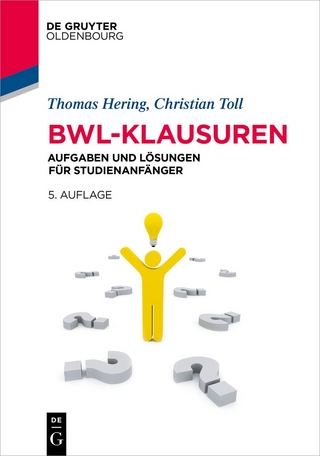
Automation, Production Systems, and Computer-Integrated Manufacturing
Addison Wesley (Verlag)
978-0-13-460546-3 (ISBN)
Provides the most up-to-date coverage of automated production systems
Automation, Production Systems, and Computer-Integrated Manufacturing provides up-to-date coverage of production systems, how they are sometimes automated and computerized, and how they can be mathematically analyzed to obtain performance metrics. The text is designed primarily for engineering students at the advanced undergraduate or beginning graduate levels in industrial, mechanical, and manufacturing engineering. The book is also useful for practicing engineers and managers who wish to learn about automation and production systems technologies in modern manufacturing.
This exploration of the technical and engineering aspects of automated production systems provides the most advanced, comprehensive, and balanced coverage of the subject of any text on the market. It covers all the major cutting-edge technologies of production automation and material handling, and how these technologies are used to construct modern manufacturing systems. The 5th Edition has consolidated and reorganized many of the topics, eliminated material that is no longer relevant, and revised end-of-chapter problems.
About our author Mikell P. Groover is Professor Emeritus of Industrial and Systems Engineering at Lehigh University, where he taught and did research for 44 years. He received his B.A. in Arts and Science (1961), B.S. in Mechanical Engineering (1962), M.S. in Industrial Engineering (1966), and Ph.D. (1969), all from Lehigh. His industrial experience includes several years as a manufacturing engineer before embarking on graduate studies. His teaching and research areas include manufacturing processes, production systems, automation, material handling, facilities planning, and work systems. He has received a number of teaching awards at Lehigh University, as well as the Albert G. Holzman Outstanding Educator Award from the Institute of Industrial Engineers (1995) and the SME Education Award from the Society of Manufacturing Engineers (2001). His publications include over 85 technical articles and books. His books are used throughout the world and have been translated into French, German, Spanish, Portuguese, Russian, Japanese, Korean and Chinese. The 1st edition of Fundamentals of Modern Manufacturing received the IIE Joint Publishers Award (1996) and the M. Eugene Merchant Manufacturing Textbook Award from the Society of Manufacturing Engineers (1996). Dr. Groover is a member of the Institute of Industrial Engineers (IIE) and the Society of Manufacturing Engineers (SME). He is a Fellow of IIE and SME.
Chapter 1 INTRODUCTION
1.1 Production Systems
1.2 Automation in Production Systems
1.3 Manual Labor in Production Systems
1.4 Automation Principles and Strategies
1.5 About This Book
PART I OVERVIEW OF MANUFACTURING
Chapter 2 MANUFACTURING OPERATIONS
2.1 Manufacturing Industries and Products
2.2 Manufacturing Operations
2.3 Production Facilities
2.4 Product/Production Relationships
Chapter 3 MANUFACTURING METRICS AND ECONOMICS
3.1 Production Performance Metrics
3.2 Manufacturing Costs
PART II AUTOMATION AND CONTROL TECHNOLOGIES
Chapter 4 INTRODUCTION TO AUTOMATION
4.1 Basic Elements of an Automated System
4.2 Advanced Automation Functions
4.3 Levels of Automation
4.4 Automation and Artificial Intelligence
Chapter 5 INDUSTRIAL CONTROL SYSTEMS
5.1 Process Industries versus Discrete Manufacturing Industries
5.2 Continuous versus Discrete Control
5.3 Computer Process Control
Chapter 6 HARDWARE COMPONENTS FOR AUTOMATION AND PROCESS CONTROL
6.1 Sensors
6.2 Actuators
6.3 Analog—Digital Conversions
6.4 Input/Output Devices for Discrete Data
Chapter 7 COMPUTER NUMERICAL CONTROL
7.1 Fundamentals of NC Technology
7.2 Computers and Numerical Control
7.3 Applications of NC
7.4 Analysis of Positioning Systems
7.5 NC Part Programming
7.6 CNC Trends and Developments
Appendix 7A: Coding for Manual Part Programming
Chapter 8 INDUSTRIAL ROBOTICS
8.1 Robot Anatomy and Related Attributes
8.2 Robot Control Systems
8.3 End Effectors
8.4 Applications of Industrial Robots
8.5 Economic Justification of Industrial Robots
8.6 Robot Programming
8.7 Robot Accuracy and Repeatability
Chapter 9 DISCRETE CONTROL AND PROGRAMMABLE LOGIC CONTROLLERS
9.1 Discrete Process Control
9.2 Ladder Logic Diagrams
9.3 Programmable Logic Controllers
9.4 Personal Computers and Programmable Automation Controllers
PART III MATERIAL HANDLING AND IDENTIFICATION
Chapter 10 MATERIAL TRANSPORT SYSTEMS
10.1 Overview of Material Handling
10.2 Material Transport Equipment
10.3 Analysis of Material Transport Systems
Chapter 11 STORAGE SYSTEMS
11.1 Overview to Storage Systems
11.2 Conventional Storage Methods and Equipment
11.3 Automated Storage Systems
11.4 Analysis of Storage Systems
Chapter 12 AUTOMATIC IDENTIFICATION AND DATA CAPTURE
12.1 Overview of Automatic Identification Methods
12.2 Bar Code Technology
PART IV MANUFACTURING SYSTEMS
Chapter 13 OVERVIEW OF MANUFACTURING SYSTEMS
13.1 Components of a Manufacturing System
13.2 Types of Manufacturing Systems
Chapter 14 SINGLE-STATION MANUFACTURING CELLS
14.1 Single-Station Manned Cells
14.2 Single-Station Automated Cells
14.3 Applications of Single-Station Cells
14.4 Analysis of Single-Station Cells
Chapter 15 MULTI-STATION MANUFACTURING SYSTEMS: MANUAL ASSEMBLY LINES
15.1 Fundamentals of Manual Assembly Lines
15.2 Analysis of Single-Model Assembly Lines
15.3 Line Balancing Algorithms
15.4 Workstation Details
15.5 Other Considerations in Assembly Line Design
15.6 Alternative Assembly Systems
Appendix 15A Batch-Model and Mixed-Model Lines
Chapter 16 MULTI-STATION MANUFACTURING SYSTEMS: AUTOMATED PRODUCTION LINES
16.1 Fundamentals of Automated Production Lines
16.2 Applications of Automated Production Lines
16.3 Analysis of Transfer Lines
Appendix 16A Transfer Lines with Internal Storage
Chapter 17 AUTOMATED ASSEMBLY SYSTEMS
17.1 Fundamentals of Automated Assembly Systems
17.2 Analysis of Automated Assembly Systems
Chapter 18 GROUP TECHNOLOGY AND CELLULAR MANUFACTURING
18.1 Part Families and Machine Groups
18.2 Cellular Manufacturing
18.3 Applications of Group Technology
18.4 Analysis of Cellular Manufacturing
Appendix 18A Opitz Parts Classification and Coding System
Chapter 19 MULTI-STATION MANUFACTURING SYSTEMS: AUTOMATED FOR FLEXIBILITY
19.1 Manufacturing Flexibility Defined
19.2 Components of an FM
19.3 Analysis of Flexible Manufacturing Systems
19.4 Alternative Approaches to Flexible Manufacturing
PART V QUALITY CONTROL SYSTEMS
Chapter 20 QUALITY PROGRAMS FOR MANUFACTURING
20.1 Quality in Design and Manufacturing
20.2 Traditional and Modern Quality Control
20.3 Process Variability and Process Capability
20.4 Statistical Process Control
20.5 Six Sigma
20.6 Taguchi Methods in Quality Engineering
20.7 ISO 9000
Appendix 20A The Six Sigma DMAIC Procedure
Chapter 21 INSPECTION PRINCIPLES AND PRACTICES
21.1 Inspection Fundamentals
21.2 Sampling versus 100% Inspection
21.3 Automated Inspection
21.4 When and Where to Inspect
21.5 Analysis of Inspection Systems
Chapter 22 INSPECTION TECHNOLOGIES
22.1 Inspection Metrology
22.2 Conventional Measuring and Gaging Techniques
22.3 Coordinate Measuring Machines
22.4 Surface Measurement
22.5 Machine Vision
22.6 Other Optical Inspection Methods
22.7 Noncontact Nonoptical Inspection Techniques
Appendix 22A Geometric Feature Construction
PART VI MANUFACTURING SUPPORT SYSTEMS AND COMPUTER-INTEGRATED MANUFACTURING
Chapter 23 PRODUCT DESIGN AND CAD/CAM IN THE PRODUCTION SYSTEM
23.1 Product Design and CAD
23.2 CAM, CAD/CAM, and CIM
Chapter 24 PROCESS PLANNING AND CONCURRENT ENGINEERING
24.1 Process Planning
24.2 Computer-Aided Process Planning
24.3 Concurrent Engineering and Design for Manufacturing
24.4 Advanced Manufacturing Planning
Chapter 25 PRODUCTION PLANNING AND CONTROL SYSTEMS
25.1 Aggregate Production Planning and the Master Production Schedule
25.2 Material Requirements Planning
25.3 Capacity Planning
25.4 Shop Floor Control
25.5 Inventory Control
25.6 Manufacturing Resource Planning (MRP II)
25.7 Enterprise Resource Planning (ERP)
Chapter 26 JUST-IN-TIME AND LEAN PRODUCTION
26.1 Lean Production and Waste in Manufacturing
26.2 Just-in-Time Production Systems
26.3 Autonomation
26.4 Worker Involvement
Appendix
Answers to Selected Problems
| Erscheinungsdatum | 22.09.2018 |
|---|---|
| Verlagsort | Boston |
| Sprache | englisch |
| Maße | 206 x 260 mm |
| Gewicht | 1820 g |
| Themenwelt | Technik |
| Wirtschaft ► Betriebswirtschaft / Management ► Unternehmensführung / Management | |
| ISBN-10 | 0-13-460546-2 / 0134605462 |
| ISBN-13 | 978-0-13-460546-3 / 9780134605463 |
| Zustand | Neuware |
| Haben Sie eine Frage zum Produkt? |
aus dem Bereich


